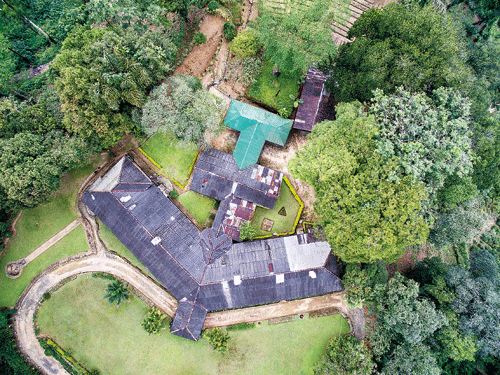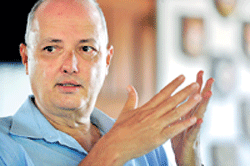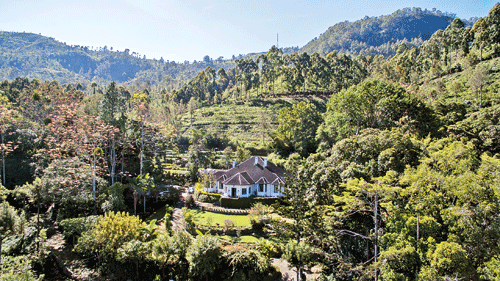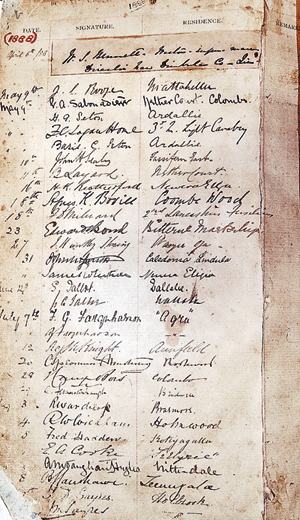Tea trails to the past

The uniquely airplane-shaped Carolina Estate Manager’s Bungalow in Ambagamuwa. Pix from Project HOCT
A walk up sloping trails flanked by velvety-green tea bushes dotted with bright red, orange, purple and yellow — the head-coverings of the humble pluckers — to summits shrouded in mist.
Breathtaking vistas which may be leisurely viewed from an aircraft-shaped bungalow while sipping a steaming cuppa.
It is a nostalgic walk into the distant past, rich with a history of tea at every little nook and corner and through recent history, forging ahead into the future with a vision.
There is, however, no necessity to leave the comfort of our homes and travel miles into the heart of the tea country in cool or balmy climes such as Nuwara Eliya, for now available at the very fingertips there is all this and more.
Welcome to Project ‘History of Ceylon Tea’ (HOCT) — the single largest repository of material going as far back as 1867 and even beyond to coffee times, with glimpses gained through invaluable meticulously-detailed Ferguson’s Directories.
More than 150 years after that “reclusive” Scotsman, James Taylor, tried out a new plant on his coffee-estate, Loolecondera in Galaha, and left two leaves and a bud to wither on the verandah of his bungalow, Project HOCT is being offered as tribute. It is for all those who, far away from home and hearth, through their toil, sweat and tears, turned the travails of coffee plantations into the triumphs of the tea plantations in then Ceylon, a strange but exotic land.
Tea, re-invigorating, refreshing, healthy and delicious, is not just another ‘hot’ drink but was and still is the very lifeblood of Sri Lanka.
Project HOCT was initiated by Dilmah Tea Founder Merrill J. Fernando and sons Dilhan and Malik, with a few hundred retired planters helping garner the information. It was presented yesterday at a simple ceremony at the Dutch Burgher Union (DBU) at Thunmulla.
This digital archive shares with the world the powerful tale of Ceylon tea, from its humble beginnings in the plantations that hug the country’s central mountains and nestle in their southern foothills, to what it is today.

David Colin-Thome: A labour of love and perseverance. Pic by Amila Gamage
“The uniqueness of Ceylon tea is defined by its quality and also the richness of its heritage. Since 1867, men and women have given their lives to our great industry, literati have been inspired by Ceylon Tea and generations have enjoyed the taste and natural goodness that Ceylon’s finest has to offer. The History of Ceylon Tea project aims to capture the incredible story to continue to inspire current and future generations of tea planters and tea drinkers alike,” says Dilhan.
It is on a humid Tuesday this week that we get the tale behind the tea-tale from the Editor of Project HOCT, David Colin-Thome, as he guides us through the mist-clad lands on his laptop, upstairs in the DBU.
“This is basically Dilhan’s vision,” says David of the digital archive which has grown in different phases and “bits and pieces” since 2002.
The idea had blossomed when Dilhan, dropping into the office of the Planters’ Association at Vajira Road, Colombo 4, flipped through yellowed, frayed and dog-eared material including the Ceylon Directory Calendar, only to realize that very soon they would be no more, leaving no record for posterity.
Earlier, Dilmah had picked David who had worked as a tea-taster for them long years before, to handle their cricket sponsorship, with a gradual expansion of his role within the company and then onto Project HOCT.
Dilhan had already got 100,000 pages of annual reports scanned and saved in a computer and David then set about getting them re-scanned and others scanned, making them into a word-searchable model under Project HOCT.
It is with reverence that David recalls how he held up the 147-year-old ‘Ceylon Directory; Calendar 1871-72’ compiled by A.M. Ferguson, Proprietor and Editor of the ‘Ceylon Observer’. Sold at 10s to subscribers it included a wealth of “useful” information and later evolved into the Ferguson’s Directory.

Dilhan Fernando: A vision to capture an incredible story
“It covered every aspect of the government and private sectors,” he says, of which the plantations were a big part. Each issue had a table denoting every estate based on what district it was in, with 50-odd plantation districts.
Fascinating is how, David describes the information covering the acreage under tea, with the names of the owner, the manager and the assistant manager for each estate recorded in every directory. The final Ferguson’s Directory was in 1999-2000.
The next phase was requesting planters to send in their career details, but it was an arduous task. So far, David has compiled a database of 10,000 from 1870 to 1930, but concedes that there are gaps as all volumes of the Ferguson’s Directory are not available.
Minute but interesting facets flow forth…….as David says how a few years back he came across the book, ‘Two Leaves and a Bud: Tales of a Ceylon Tea Planter’ by Charles F. Brooke-Smith which also included his long association with Spring Valley Estate in Badulla from the 1930s.
“Seeing a phone number in England for him on the back of the book, I called it expecting to hear from a descendant, if at all,” he says, taken by surprise when the voice at the other end said: “I’m Charles”. He was in his 90s and spoke with a strong voice. “I believe he died a couple of years ago aged 98.”
Links crisscrossing the world, accolades and a little more history from the kith and kin of these pioneering tea planters – the latest, just last Sunday from Helen Kiberd commenting on John Laing “my Great-Great-Grandfather from Aberdeen! How lovely to see he is still alive on the Internet”.
Ken Jacobson from Essex compliments the “remarkable” site which helped him to research Charles Scowen, who acquired Holton Estate, while G. Varder refers to B.B. Rodger and the “uniquely informative” webpage.

The Nayabedde Estate Manager’s Bungalow in Bandarawela, in a picturesque setting
“I came across a copy of an old A.A. Milne book in Johannesburg, signed by B.B. Rodger and stamped by a bookseller in Kandy. I was curious to find out more. Thanks to your register, it emerged that there was indeed a B.B. Rodger working as assistant manager on plantations in the 1920s. This made an amazing link-up with the volume in hand,” he says.
Sue Patterson, meanwhile, who had visited Sri Lanka, talks of the Handunugoda plantation which was an “absolute delight”.
The efficient 140-year-old machinery still operating so smoothly is a wonderfully informative experience, exhibiting amazing engineering skills of those bygone Victorian days. Having tea up at the beautiful stately old plantation house, plunged us back into those fascinating bygone years, adding an extra enchantment to this lovely plantation, she says, adding that she has researched her late father-in-law’s WW II history and found that on his way to Singapore his ship stopped in Colombo (this would have been 1941/42) and he managed to meet up with his cousin John Middlemiss who was working on one of the plantations.
She is “interested” to know on which tea plantation or plantations John Middlemiss worked at and whether there may be any Middlemiss descendants still living in Sri Lanka!
In the next phase, David armed with a powerful camera has been sojourning to numerous estates to photograph the manager’s bungalow and the plantation itself as it is today. Very modern technology, drone photography, is also being utilized to get images from different heights.
David feels a special affinity with the Rothschild estates in Pussellawa and Ramboda, where even before the ‘Father of Tea’ James Taylor ventured into this industry, Maurice Worms and his brother from the clan of the Rothschild financiers, cultivated tea plants brought from China.
Back at the digital archive, many have also been the challenges, with the varied spelling of the same name giving David a headache and setting off different entries when searches are made.
But, like those robust planters of yore, David with Dilmah’s unstinting support, is persevering and as he says in his introduction: “The ‘History of Ceylon Tea’ project is a tribute to those courageous men of whom Conan Doyle spoke, that the memory of their sacrifice and dedication in creating a great and life-giving industry shall not be dimmed with time.”
Project HOCT, a non-profit mission, is a labour of love not only for Sri Lanka’s ‘queen’ of beverages, tea, but also for posterity.
| Find them online | |
| Project HOCT brings under one cloud ancient and often unique publications improperly stored in various state departments. “The publications where copyright is thought to have lapsed are also being made available online,” says David.Clicking on this digital archive http://www.historyofceylontea.com/: opens up an easy-to-navigate site, replete with descriptions dotted with lots of photographs and videos. The ‘Timeline’ ‘Pioneers’, ‘Tea Estates’, ‘Planters’ it is all there, easily searchable.Under the ‘Timeline’ is the plantation history in the context of both international history and local history, giving in a nutshell a ‘rounded’ look at those times.There are also contributions from private collectors which David hopes would grow and an interactive Forum where planters and enthusiasts can exchange ideas and share experiences, thoughts and views.The website includes profiles of more than 10,000 planters currently with additions ongoing; a searchable database of more than 4,000 individual plantations; video interviews with important current and former industry-related personalities; an extensive digital library with more than 300,000 scanned pages of historical publications; and more than 50 scanned editions of the Ferguson’s Directories from 1871. For more information, David is contactable on e-mail: editor@historyofceylontea.com
 The first page of the Diyagama West Estate Factory visitors’ book dating back to 1888 |
| When Jack Hobbs came to Darrawela and more | |
 A photograph, accompanied by a piece of writing from the Times of Ceylon, dated 17 February 1891, recorded that three days earlier a Russian party led by the Czarevitch, later Nicholas II, Emperor of Russia, paid a visit to the Darrawela Club! He was the last Emperor of Russia and following the 1917 Revolution, he and his family were executed. Lifted out of the pages of history is the Darrawela Club (the Dickoya and Maskeliya Cricket Club – DMCC), an important feature of Project HOCT. With tea and cricket being inextricably-linked, David says that Darrawela close to Dickoya was one of the most prominent planters’ clubs with an impressive array of photographic memorabilia dating back to 1870, which have been re-photographed and digitized on http://www.historyofceylontea.com/media-archive/darrawella-club He paints “a pretty picture” of its location, while stating that “even today, a silent stroll through the silent corridors of the clubhouse; the silent library, or the silent billiard room; absurdly, even a silent bar – an active imagination is not required to conjure up images of what, indeed, must have been a very lively and grand lifestyle!” He picks out a photograph of the DMCC and Dimbula Athletics and Cricket Club (Radella Club) teams, in their very first encounter in 1870 and says that this rivalry is one of the island’s earliest cricketing fixtures between any two teams.  Tea planters played an integral role in popularizing cricket and rugby in the island. This is the MCC team which toured Ceylon in 1934, who played against an Up-Country XI at Darrawela. The MCC were led by controversial Douglas Jardine who two years earlier introduced the infamous ‘bodyline theory’ against Sir Donald Bradman’s Australians. This tour of Ceylon by the MCC, which was preceded by a three Test match tour of India, was to be the last occasion that Jardine represented his country. “One of the Darrawela Club’s most prestigious associations with cricket’s historical fame was the visit paid to it by the legendary Sir Jack Hobbs, in 1930. To date, the large personally autographed photograph of Sir Jack, in batting stance at the club grounds, is a much-revered item of memorabilia,” says David, adding that from some accounts, lasting impressions of Sir Jack’s visit do not appear to have been a one-way street. According to former tea planter and past Club President, Dushy Perera, a hand-me-down tale at the club was that Sir Jack, upon his return to England, named his cottage ‘Darrawela’. He puts under the spotlight “an equally valued item” of memorabilia – that of a team photograph of the Marylebone Cricket Club (MCC) visit in 1934. Pitted against an Up-Country XI at Darrawela, the MCC were led by that most controversial of characters, Douglas Jardine who two years earlier prompted the game’s most divisive incident when he introduced the infamous ‘bodyline’ theory against the Australians. “This club did not merely play host to showy cricket teams and cricketers. A photograph, accompanied by a piece of writing from the Times of Ceylon, dated 17 February 1891, recorded that three days earlier a visit was paid to the Darrawela Club by a Russian party led by the Czarevitch, later Nicholas II, Emperor of Russia!” adds David.
|


